텍스텀 클럽(Textum Club)은 패션비평과 관련된 프랙티스와 출판을 위한 연구모임입니다. 직물을 뜻하는 ‘textile’과 글을 의미하는 ‘text’의 공통 어원인 ‘엮다’는 뜻을 가진 텍스텀 클럽은 패션 비평 아카이브로써 비평적 패션(Critical Fashion) 관련 국내외의 도서를 소개합니다.
비평적 패션 프로젝트 및 담론의 지속적 연구와 확산을 위해 전시, 출판, 연구, 워크숍 등 다양한 활동을 추진하여 국내외의 디자이너, 예술가, 연구자, 패션종사자의 네트워크장으로써 기능하고자 합니다.
Textum Club is a research group dedicated to practices and publishing in fashion criticism based in Seoul. Derived from the common roots of 'textile' and 'text,' meaning 'to weave,' Textum Club introduces books and articles related to critical fashion as part of its fashion criticism archive.
It aims to serve as a networking platform for designers, artists, researchers, and fashion practitioners globally through various activities including exhibitions, publishing, research, and workshops.
テキスタムクラブ(Textum Club)は、ファッション批評に関する実践と出版のためのリサーチグループです。布地を意味する「textile」と、文章を意味する「text」という言葉の共通の語源である「編む(texere)」という概念に基づくテキスタムクラブは、ファッション批評のアーカイブとして、クリティカル・ファッション(Critical Fashion)に関連する各国の書籍を紹介しています。
批評的ファッションのプロジェクトやディスコースの継続的な研究と普及を目指し、展覧会、出版、リサーチ、ワークショップなど多様な活動を展開しながら、各国のデザイナー、アーティスト、研究者、ファッション関係者のネットワークの場として機能することを目指しています。
-
김서희는 세히쿄(SEHIKYO) 프로젝트를 운영하며 착용자들과 협업하는 방식으로 옷을 입는 아이디어를 공유하고 있습니다. 전시, 워크숍, 프레젠테이션을 통해 전통적 패션 시스템에 의존하지 않는 대안적 프랙티스를 연구하고자 합니다.
www.sehikyo.orgThe SEHIKYO project is managed by Seohee Kim, who shares innovative ideas about clothing through collaboration with wearers. Through exhibitions, workshops, and presentations, she explores alternative practices that challenge the traditional fashion system, aiming to establish a new paradigm in how fashion is perceived and practiced. More details about her work and contributions can be found on the www.sehikyo.org
キム・ソヒはSEHIKYO(セヒキョ)プロジェクトを運営し、着用者との協働を通じて「服を着る」というアイデアを共有しています。展覧会、ワークショップ、プレゼンテーションを通して、従来のファッションシステムに依存しない代替的なプラクティスの探求を目指しています。www.sehikyo.org
-
김연우는 큐레이터, 연구자, 제작자로 활동하고 있으며, 텍스텀 클럽의 공동 창립자로서 패션 비평과 관련된 연구, 전시, 출판 활동을 수행하고 있습니다. 그녀는 2023 청주 공예 비엔날레를 비롯하여 서울과 제주에서 공예와 예술 관련 다양한 전시를 큐레이션했습니다. 연세대학교에서 철학과 의류환경을 공부한 후, 센트럴 세인트 마틴과 영국 왕립 예술 대학교에서 패션을 전공했습니다. 그녀는 패션 현상의 철학적 분석에 대한 이론과 실천을 연구하며, 패션에 대한 대안적인 시각을 제공하고자 합니다.
www.fashionknowledgehoarder.comYeonwoo Kim works as a curator, researcher, and maker, and is a co-founder of Textum Club, where she engages in research, exhibitions, and publishing related to fashion criticism. She has curated various craft and art exhibitions in cities including Seoul and Jeju, notably the 2023 Cheongju Craft Biennale. After studying philosophy and clothing environment at Yonsei University, she pursued fashion at Central Saint Martins and the Royal College of Art in the UK. She researches the theory and practice of philosophical analysis of fashion phenomena, aiming to provide an alternative perspective on fashion. More details about her work and contributions can be found on the www.fashionknowledgehoarder.com
キム・ヨヌはキュレーター、研究者、そしてクリエイターとして活動しており、テキスタムクラブの共同設立者として、ファッション批評に関するリサーチ、展覧会、出版活動を行っています。彼女は2023年の清州工芸ビエンナーレを含め、ソウルや済州で工芸とアートに関する様々な展覧会をキュレーションしてきました。延世大学で哲学と衣類環境を学んだ後、セントラル・セント・マーチンズおよび英国王立芸術大学でファッションを専攻しました。彼女はファッション現象の哲学的分析に関する理論と実践を研究し、ファッションに対する新たな視点を提示することを目指しています。www.fashionknowledgehoarder.com
-
황혜림은 시각예술 및 공예 분야에서 활동중인 큐레이터입니다. 분단, 장애, 게임, 웹툰 등 경계에 머무는 것들에 대해 많은 관심을 갖고, 연구 및 전시 활동에 참여하고 있습니다.
Hwang Hyerim is a curator active in the fields of visual arts and crafts. She has a keen interest in topics residing at boundaries such as division, disability, gaming, and webtoons, and is involved in research and curatorial projects related to these themes.
ファン・ヘリムは、視覚芸術および工芸の分野で活動しているキュレーターです。分断、障害、ゲーム、ウェブトゥーンなど、境界にとどまるものごとに強い関心を持ち、リサーチや展覧会の活動に取り組んでいます。
-
텍스텀 클럽의 활동에 관심이 있는 여러분의 참여를 환영합니다! 패션과 관련된 책이나 주제를 추천해주세요. 또한 문의사항이 있다면 언제든지 저희에게 메일을 보내주세요.
We welcome your participation in Textum Club’s activities! Please recommend books or topics related to fashion that interest you. If you have any questions, feel free to email us at any time.
テキスタムクラブの活動にご関心のある皆さまのご参加を心よりお待ちしております。ファッションに関する書籍やテーマのご推薦もぜひお寄せください。ご質問などがありましたら、いつでもお気軽にメールでご連絡ください。
textum.club@gmail.com
@textum.club
textum.club@gmail.com
@textum.club
textum.club@gmail.com
@textum.club
나카코 하야시: 여기와 저기에 존재하기 - 시스템 너머의 패션
Nakako Hayashi: To Be here and there - Fashion Beyond the System
林央子: To Be here and there - Fashion Beyond the System
비평적 패션 실천의 지평에서, 독립 매체의 존재는 산업적 제약을 넘는 담론의 가능성을 끊임없이 실험해왔다. 하야시 나카코(林央子)는 일본 패션 언론계에서 다년간 활동한 편집자이자 작가로서, 그간의 실무적 경험과 문화 간 감수성을 바탕으로 독립 잡지 『here and there』를 창간하였다. 이 잡지는 단순한 패션 리포트의 범주를 넘어, 예술, 생활 양식 등 서로 다른 창작 영역 간의 교차 지점을 탐색하며, 비상업적이고 자율적인 담론의 공간으로 자리매김해왔다.
하야시는 시세이도의 월간지 『花椿(하나츠바키)』 편집자로서의 커리어를 기반으로, 기존 패션 시스템의 한계를 인식하고 이를 비껴나가는 실천적 실마리로 『here and there』를 구축해왔다. 특히 “편집자는 자신의 삶을 살아가는 하나의 개인일 뿐이며, 잡지는 어떤 ‘정답’을 제시하는 포교적 수단이 되어서는 안 된다”는 하야시의 윤리적 태도는, 상업주의로 치우친 패션 미디어 환경 속에서 잡지가 지닐 수 있는 공론장의 가능성을 되묻는다.
이러한 접근은 잡지를 소비의 대상이 아닌 사회적·정치적 감각을 수반한 창작의 매개로 전환시키며, 빠른 순환을 요구하는 디지털 시대에 맞서 인쇄 매체의 물성과 시간성, 그리고 신체적 개입을 통한 느린 저항(slow resistance)의 형태로 작동한다. here and there는 단순한 매체를 넘어 관계 맺기의 윤리와 창작의 과정을 재구성하는 실천적 플랫폼이자, 확장하는 패션(expanding fashion)을 탐색하는 하나의 사례다. 이번 인터뷰는 이러한 실천을 가능하게 한 철학과 전략, 그리고 “잡지는 어떤 관계를 만들 수 있는가?”, “패션은 어떻게 삶의 실감과 연결되는가?”, “창작은 자본과 무관하게 지속 가능할 수 있는가?”라는 질문을 따라가는 기록이다.
텍스텀 클럽
간단한 자기소개와 『here and there』라는 잡지에 대한 소개를 부탁드립니다.
나카코 하야시
결혼 후 성은 ‘무라노(村野)’로 바뀌었지만, 오랫동안 예전 성을 사용해 ‘하야시 나카코(林央子)’라는 이름으로 편집 및 집필 활동을 해왔습니다. 패션, 예술, 건축 등 분야를 넘나들며, 무언가를 만들거나 살아가는 방식을 탐구하는 사람들과 친구가 되어왔습니다. 사람들과의 교류를 통해 얻은 깊은 깨달음을 공유하고 싶어서 『here and there』라는 장을 만들게 되었습니다. 잡지라는 형태를 택한 이유는, 10년 이상 월간지 편집에 종사했던 경험이 있고, 그 세계가 가장 자신에게 맞고 표현하기 쉬운 분야였기 때문입니다. 일본 사회에서 느끼는 답답함을 해소하고자 해외 사람들과 소통할 수 있는 이중언어 출판을 고집한 것도 중요한 이유 중 하나였습니다.

here and there, v.6, p.06-07
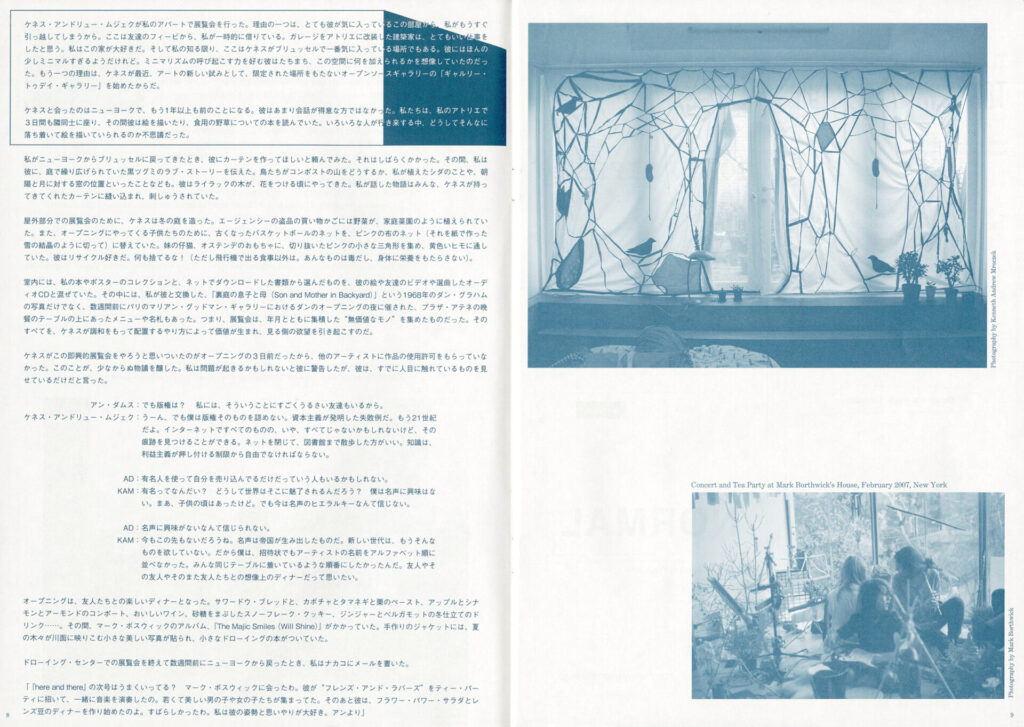
here and there, v.6, p.08-09
텍스텀 클럽
『here and there』를 창간하게 된 계기와, 그 과정에서 특히 중시한 부분은 무엇인가요?
나카코 하야시
직접적인 계기는 회사를 그만두고 프리랜서가 된 것입니다. 시세이도(資生堂) 사원으로서 월간 PR지 『하나츠바키(花椿)』를 편집할 당시, 연 2회 파리 패션위크를 취재하러 다녔습니다. 그 경험을 자신만의 아웃풋으로 만든 것이 『Paris Collection Individuals』(1, 2 리틀모어 출판)라는 연 1회 발간되는 이중언어 서적이었는데, 파리나 패션위크에 국한하지 않고 스스로 흥미로운 주제를 추가해 자유롭게 정리했습니다. 프리랜서가 되면서 여러 제약에서 벗어나 보다 ‘자유롭게’ 발신하고자 고민했고, 패션 리포트뿐만 아니라 여행이나 주거처럼 일반적으로는 패션과 무관하다고 여겨지는 주제도 사실은 패션과 깊이 관련되어 있다는 것을 보여주기 위해 기사 범위를 넓혔습니다. 무엇보다 “자유”를 중요시했습니다. 또, 도쿄/일본이 단순한 소비의 장이 아니라 문화 발신과 창조의 장소이기도 하다는 점을 주장하고자 했습니다. 『here and there』의 제작에는 한 가지 규칙이 있는데, 내가 직접 대화할 수 있는 네트워크 범위 내에서만 작업한다는 것입니다. 잡지 제작 과정에서 다양한 어려움이 생길 수 있음을 경험으로 알고 있었기 때문에, 이를 최대한 피하고 지속 가능한 형태를 지향하기 위함이었습니다.
텍스텀 클럽
각 호의 테마를 선택하는 기준과, 그 테마를 통해 독자에게 전달하고 싶은 메시지는 무엇인가요?
나카코 하야시
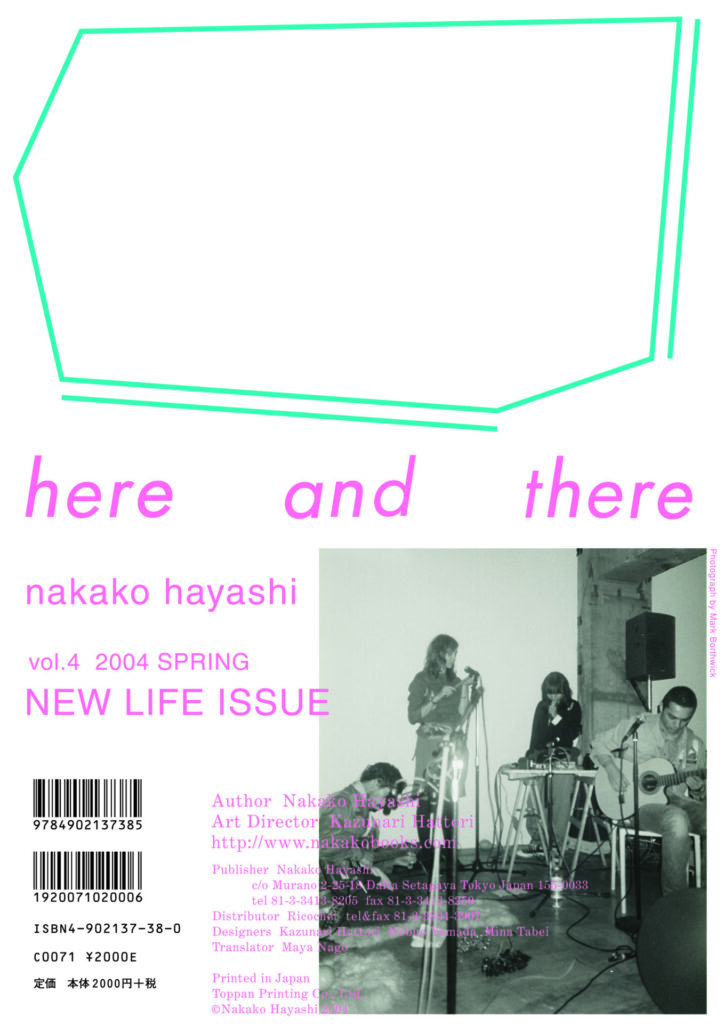
here and there, v.4, cover page
테마를 정하기 시작한 것은 vol.4부터입니다. 그 전까지는 기분에 충실하기 위해 일부러 테마를 설정하지 않았습니다. 그러나 출산 후 생활 변화로 인해, 편집 작업을 보다 수습하기 위해 테마 설정이 필요하게 되었습니다. 항상 ‘당시의 나에게 있어 타인과 공유하고 싶은 절실한 주제’이면서, ‘일이나 관찰을 통해 매우 의미있다고 느껴진 아웃풋’을 바탕으로 테마를 정해왔습니다. 2015년 정도까지는 잡지 라이터로서 상업 패션지나 문화/예술 잡지에서도 일하면서, 『here and there』를 스스로 깊게 생각하는 공간으로 삼아왔습니다.
텍스텀 클럽
잡지에서 소개할 작가나 디자이너를 고를 때 중요하게 여기는 요소는 무엇인가요?
나카코 하야시
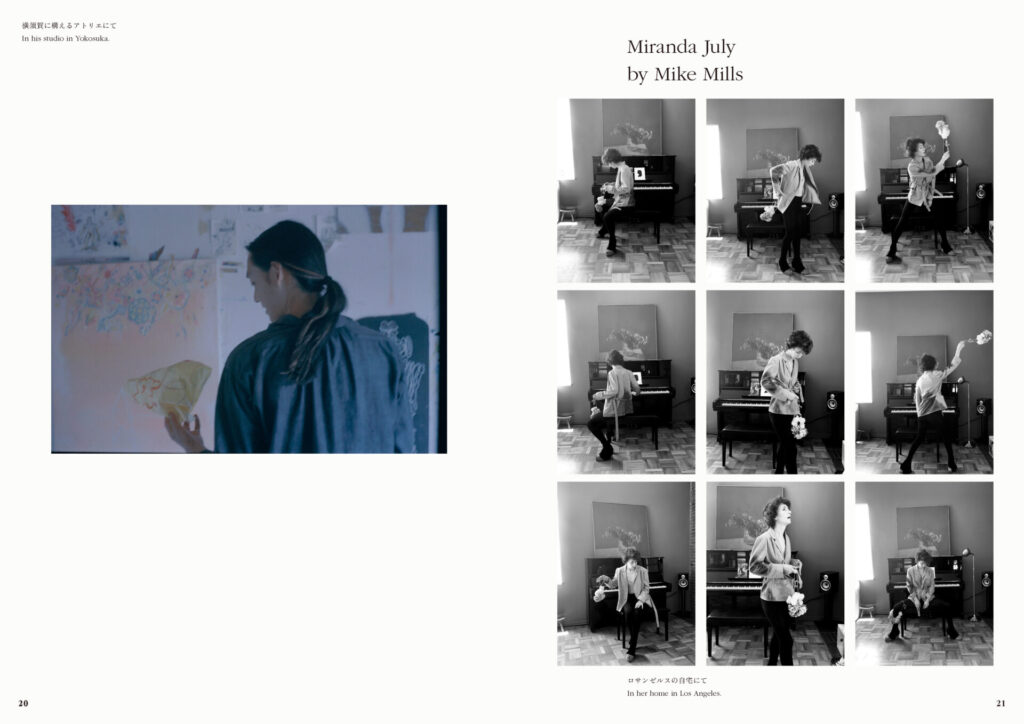
here and there, v.14, p.20-21
패션 미디어가 빠지기 쉬운 함정은 일방적인 커뮤니케이션입니다. 편집자, 모델, 헤어메이크업 아티스트, 의상, 포토그래퍼 등이 공동으로 만들어낸 패션 이미지를 “최고”라고 제시하는 답안형 패션사진. 그런 현장에서 오랫동안 일하며 큰 의문을 느꼈습니다. 『here and there』에서는 vol.14에서 처음으로 패션 사진을 다루었지만, 이는 일반적인 구조를 바꿔, 세계 각지의 피사체가 스스로 좋아하는 촬영자를 골라 둘만의 방식으로 촬영하는 형태를 취했습니다. 작가나 디자이너에 대해서는 특히 패션에 대해 새로운 사고를 제시하는 이들의 활동에 오래 관심을 가져왔습니다. 이들의 활동을 ‘해답’으로 제시하는 것이 아니라, 사고가 진행되는 과정을 담고 싶었습니다. 그래서 잡지라는 시대성과 밀접하게 연결된 표현 매체를 통해 자신만의 형태로 발신하고자 했습니다.
텍스텀 클럽
『here and there』가 기존 패션잡지와 다른 방향(비상업성, 독특한 창작자 소개)을 선택한 이유와, 이 접근이 현대 패션업계 및 잡지 문화에서 가지는 의미는 무엇인가요?
나카코 하야시
항상 자신의 끌림과 호기심에 충실한 선택을 한 결과, 현대 패션업계 속에서 하나의 확고한 방향성을 가지게 된 것처럼 보일 수도 있습니다. 『here and there』가 각자가 ‘자신이 좋아하는 것’에 대해 깊이 생각하는 계기가 된다면 정말 기쁘고 영광입니다. 나는 잡지가 어떤 ‘포교’를 위한 수단이어서는 안 된다고 믿습니다. 편집자가 자신의 삶을 이야기하며 사람들에게 같은 삶과 사고, 소비를 강요하는 것이 아니라, 다양한 상황 속에서 살아가는 개인들이 ‘함께 살고, 함께 생각하고, 함께 창조하는’ 공간이기를 원합니다.
텍스텀 클럽
잡지를 발행하며 비상업적 태도를 유지할 때 가장 큰 어려움과 이를 극복하기 위한 전략은 무엇이었나요?
나카코 하야시
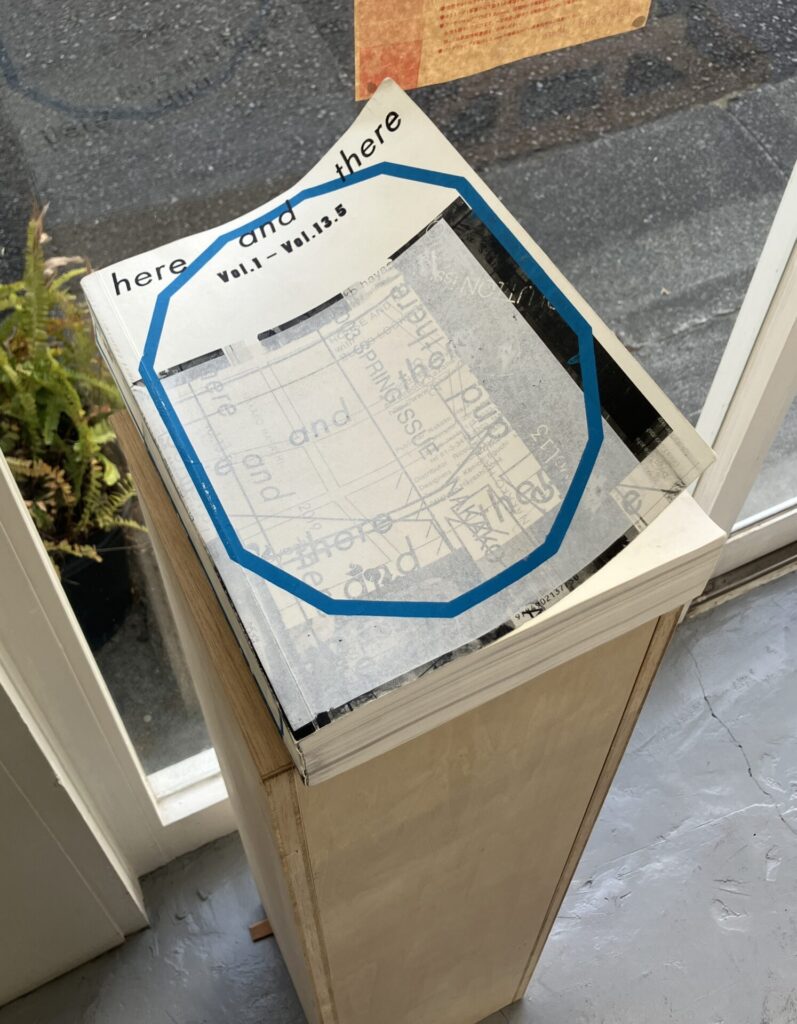
here and there, v.13.5, exhibition view
제작 비용을 어떻게 마련할지가 가장 큰 문제였습니다. 초기 전략은 대기업 광고에만 의존하지 않고, 활동에 공감해줄 수 있는 개인사업자로부터 소규모 광고를 받는 공간을 만들었습니다. 활동 후기에는 독자가 함께 즐길 수 있는 출판 이벤트를 기획해, 공헌자들과 함께 만들었습니다. 『here and there』13.5는 그런 이벤트의 기록집입니다. 이런 전략은 자금난을 직접 해결하는 방법이라기보다는, 매체에 대한 신뢰와 사람들과의 유대를 실감하는 데 초점을 맞추었습니다. ‘지금 여기 있고 싶은 사람과 손을 잡는다’는 편집 방침을 지키며, 광고주이든 독자이든 협력자이든, 그 순간 희망하는 사람들과 네트워크를 이어가는 것을 ‘전략’으로 삼았습니다.
텍스텀 클럽
디지털 미디어가 발달한 오늘날, 인쇄 매체로 활동을 지속하는 이유와 그 의미는 무엇인가요?
나카코 하야시
책이나 잡지라는 인쇄물은 독자가 저자나 기사 내용과의 ‘대화’를 신체적으로 느낄 수 있는 매체입니다. 공예품처럼 시간과 손길을 들여 만들어집니다. 나에게 대화는 살아가는 데 필수적인 행위입니다. 그렇게 이루어진 대화를 인쇄라는 형태로 공유함으로써, 의도를 넘어서는 만남을 만들어낼 수 있다고 믿기에 인쇄 매체 활동을 계속하고 있습니다.
텍스텀 클럽
기존 패션 시스템(예: 파리 패션위크 중심 구조)에서 벗어나 “확장하는 패션”을 추구하고 있다고 들었습니다. 이 개념을 연구하면서 발견한 새로운 가능성과 역할은 무엇인가요?
나카코 하야시
일상생활 속에서 다양한 패션의 가능성과 역할을 깨닫게 됩니다. 예를 들어 어제는 ‘피팅(試着)’이라는 행위에 대해 생각했습니다. 취약한(vulnerable) 상태를 감수하고 낯선 공간에서 갈아입기를 마다하지 않는 이유는 무엇일까요? 새 옷을 입는 것은 패션의 즐거움 중 하나입니다. 입어봄으로써 스스로에게 어울리는지를 체험합니다. 그 순간은 노력이나 자본이 아니라, ‘자신과 옷이 조화를 이뤄 더 나은 자신을 끌어낼 수 있는지’를 체감하는 특별한 순간입니다. “멋지다”고 누군가의 옷차림을 칭찬하는 순간에도, 브랜드가 아니라 ‘그 사람에게 어울리는지’를 기준으로 할 때, 입는 사람과 보는 사람이 함께 새로운 의미를 창출하는 자리에 서 있게 됩니다. 수평적 관계 속에서 새로운 의미를 공동 생성하는 커뮤니케이션 방식에 깊은 관심이 있습니다. “확장하는 패션”은 그런 관계를 일상 속에서 자연스럽게 체험하게 해주는 장이라고 생각합니다.
텍스텀 클럽
『here and there』에서 소개된 작가들의 작업이 자본주의적 트렌드나 패션 업계의 규범과 대비되어 보입니다. 이들이 잡지 철학과 어떻게 대화하고 있다고 생각하시나요?
나카코 하야시
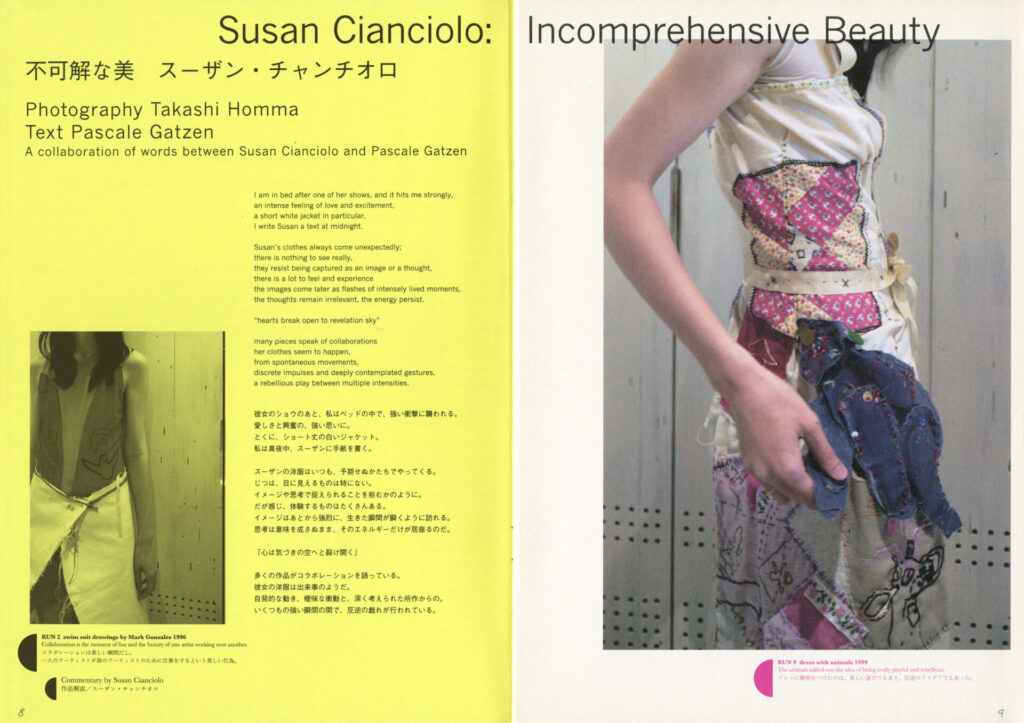
here and there, v.11, p.08-09
수잔 챤치올로, BLESS, 파스칼 가텐과의 대화 속에서도 이러한 대비는 자주 등장했습니다. 처음 만났을 때, 우리 모두 패션 디자이너와 저널리스트라는 입장에서 그 ‘현장’에 있었고, 함께 느꼈던 위화감이 관계의 출발점이 되었습니다. 그런 상황 속에서 서로 어떤 방식으로 균형을 맞추고 조율해 나갈 수 있을지 시험하고 고민하는 과정을 거쳤습니다. 그러는 사이, 예술계의 상업주의 흐름에 염증을 느낀 다른 창작자들도 자신들의 문제를 함께 다루기 위해 모여들기 시작했습니다. 장르를 넘어, 삶 속에서 느끼는 문제들을 공유하는 매체로 자리 잡아간 것이지요. 이러한 방향성은 편집자가 의도적으로 기획한 것이 아니라, 자연스럽게 그렇게 ‘모여진’ 흐름이었습니다.
텍스텀 클럽
패션과 사회적 과제를 연결할 때 가장 중요하다고 생각하는 점과, 연구를 통해 느낀 유럽과 일본 패션 업계의 공통점이나 차이점이 있다면 알려주세요.
나카코 하야시
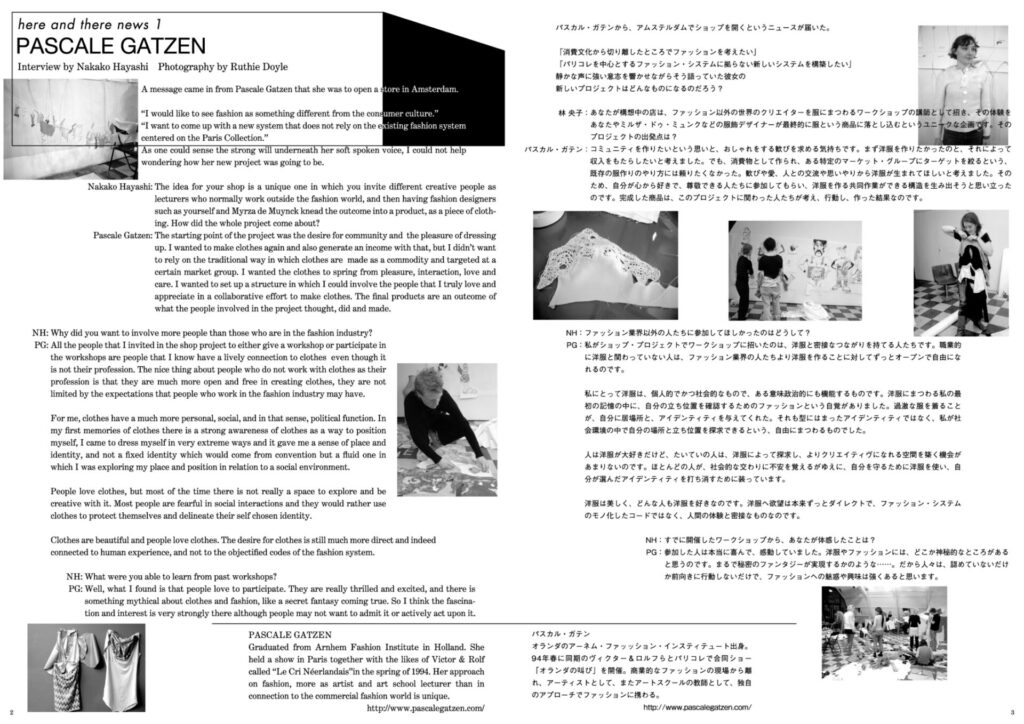
here and there, v.7
패션은 사회 속에서 살아 숨 쉬는 것이기에 사회적 문제에 맞설 수도 있습니다. 그러나 상업 패션 세계에서 이러한 문제를 직접적으로 다루는 것은 쉽지 않습니다. 연구나 아트 프로젝트 같은 다른 틀에서 시도하는 것이 더 중요할지도 모릅니다. 그럼에도 불구하고, 패션을 경유해 사회 문제를 다루려는 실천은 여기저기서 나타나고 있으며, 앞으로 변화할 가능성도 충분히 있다고 생각합니다. 패션 업계의 좋은 점은 감각적으로 좋은 것을 언어화하기 전에 직관적으로 판단할 수 있다는 점입니다. 이는 유럽과 일본 모두에 공통된 특징이라고 생각합니다.
텍스텀 클럽
앞으로의 새로운 프로젝트나 『here and there』의 향후 전망을 알려주세요.
나카코 하야시
현재 런던 칼리지 오브 패션 박사과정(PhD)에서 패션 저널리즘을 연구 중입니다. 『here and there』를 분석하는 참여형 리서치(participatory research)의 일환으로, 콜라보레이티브 진 메이킹(collaborative zine making) 전시와 워크숍을 기획했습니다.
사람들이 ‘무언가를 만드는 체험’에서 점점 멀어지며 삶의 실감을 잃어가는 문제를 인식하고 있으며, 모두가 창작자가 될 수 있는 기회를 만들어나가길 희망합니다. 2025년 2~3월에는 『here and there』 vol.16을 ‘리딩룸’ 형태의 공간으로 구성하고, 제가 런던 칼리지 오브 패션에 지원할 당시 품었던 리서치 질문을 바탕으로 설문지를 제작하여, 방문자들과 함께 사유를 나누는 체험을 시도했습니다. 친밀한 연구자들과 함께 리소그래프 인쇄 방식으로 만든 진을 전시·판매했고, 패션에 대해 진지하게 함께 생각할 수 있는 공간을 마련했습니다. 처음 진을 만들어보는 사람들을 위한 워크숍도 열었습니다. 이 경험은 편집자로서 잡지를 만들어온 경험과는 전혀 다른 새로운 체험이었으며, 앞으로 이 연구가 어떤 방향으로 나아갈지 저 역시 기대하고 있습니다.
© Textum Club. 일부 콘텐츠는 원저작자 및 출판사에 저작권이 있습니다. 무단 복제 및 사용을 금합니다.
In the landscape of critical fashion practices, the presence of independent media has continuously explored the possibilities of discourse beyond the constraints of the industry. Nakako Hayashi (林央子), an editor and writer with many years of experience in Japanese fashion journalism, launched the independent magazine here and there drawing on her practical background and cross-cultural sensitivity. This magazine moves beyond the boundaries of a traditional fashion report, examining the intersections of various creative fields such as art and lifestyle, and has established itself as a space for non-commercial, autonomous discourse.
Building on her career as an editor at Shiseido’s monthly magazine Hanatsubaki (花椿), Hayashi recognised the limitations of the existing fashion system and developed here and there as a practical outlet that sidesteps these constraints. Her ethical stance—“an editor is simply an individual living their own life, and a magazine should not become a proselytising tool that presents the ‘right answer’”—raises questions about the potential of magazines to act as a public forum in a fashion media landscape dominated by commercialism.
This approach reframes the magazine not as an object of consumption but as a medium for creation imbued with social and political sensibilities. In resistance to the fast-paced circulation of the digital age, it operates as a form of slow resistance—through the materiality and temporality of print media and physical engagement. here and there functions not merely as a medium, but as a practical platform that reconfigures the ethics of connection and the process of creation, and as an example of expanding fashion. This interview traces the philosophy and strategies that have enabled such practices, guided by questions such as: “What kinds of relationships can a magazine cultivate?”, “How is fashion connected to the felt experience of life?”, and “Can creation be sustained independently of capital?”
Textum Club
Could you briefly introduce yourself and tell us about the magazine here and there?
Nakako Hayashi
Although my surname changed to “Murano” (村野) after marriage, I have long been working under my former name, “Nakako Hayashi” (林央子), as an editor and writer. I’ve built friendships with people who engage in making things and exploring ways of living, across disciplines such as fashion, art, and architecture. I created here and there as a space to share the deep insights I’ve gained through these encounters. I chose the magazine format because I had over a decade of experience editing a monthly magazine, and that world felt the most natural and expressive to me. Another key reason was my desire to overcome the frustrations I felt within Japanese society by publishing bilingually, enabling communication with people overseas.

here and there, v.6, p.06-07

here and there, v.6, p.08-09
Textum Club
What inspired you to launch here and there, and what did you particularly value in the process?
Nakako Hayashi
The immediate trigger was becoming a freelancer after leaving my job. While working as an in-house editor at Shiseido on the monthly PR magazine Hanatsubaki (花椿), I travelled to Paris Fashion Week twice a year. As a personal output from those experiences, I began publishing a bilingual annual book titled Paris Collection Individuals (Volumes 1 and 2, published by Little More), which allowed me to compile not just fashion-week content but also additional themes I found interesting. After going freelance, I wanted to communicate more freely, beyond fashion reports, to show how topics often perceived as unrelated to fashion—such as travel or housing—are actually deeply connected to it. I prioritised “freedom” above all. I also wanted to assert that Tokyo and Japan were not just spaces of consumption but also of cultural creation and transmission. There’s one guiding principle in producing here and there: I only work within the network of people I can speak to directly. Having experienced the various difficulties that can arise during magazine production, I wanted to minimise those risks and aim for a sustainable format.
Textum Club
How do you choose the themes for each issue, and what messages do you hope to convey through them?
Nakako Hayashi

here and there, v.4, cover page
I began setting themes from volume 4 onwards. Prior to that, I deliberately avoided themes in order to follow my instincts more freely. However, after giving birth and experiencing major life changes, it became necessary to set themes in order to better manage the editing process. The themes are always based on topics I personally feel a strong urge to share with others at that time—topics that emerge from work or observation and feel particularly meaningful.
Until around 2015, while working as a writer for commercial fashion and cultural magazines, here and there served as a space for deeper personal reflection.
Textum Club
What do you look for when selecting artists or designers to feature in the magazine?
Nakako Hayashi

here and there, v.14, p.20-21
One common trap in fashion media is one-way communication. For instance, fashion photographs that present the final look—created by editors, models, hair and makeup artists, stylists, and photographers—as “the answer.” Having worked in such settings for a long time, I began to feel deeply uneasy about that approach. In here and there, fashion photography was introduced for the first time in vol.14, but the usual structure was reversed: subjects from around the world chose their own photographers and worked together to create images in their own ways. When it comes to artists or designers, I’ve long been interested in those who propose new ways of thinking about fashion. Rather than presenting their work as a “solution,” I aim to document the thought processes behind their creations. That’s why I use the magazine—a medium closely tied to the times—as a space to communicate those ideas in my own way.
Textum Club
Why did you choose a non-commercial, creator-focused direction that differs from conventional fashion magazines? What meaning does this approach hold in the current fashion industry and magazine culture?
Nakako Hayashi
In truth, what looks like a deliberate stance within the contemporary fashion industry is simply the result of always following my own instincts and curiosities. If here and there can become a trigger for readers to deeply think about what they love, then I feel truly honoured. I don’t believe a magazine should serve as a tool for “proselytising.” Instead of pushing my way of life, thought, or consumption onto others, I want it to be a shared space where individuals living under various circumstances can “live together, think together, and create together.”
Textum Club
What has been the biggest challenge in maintaining a non-commercial attitude while publishing the magazine, and how have you addressed it?
Nakako Hayashi

here and there, v.13.5, exhibition view
The greatest challenge has always been how to secure production costs.
My initial strategy was to avoid relying solely on major corporate advertising, and instead create space for small-scale advertisements from independent businesses who resonated with the magazine’s ethos. Later, I organised publication events that readers could join, co-created with contributors. here and there 13.5 is a record of such an event. Rather than directly solving financial problems, this strategy focused on building trust in the publication and fostering personal connections. Following the editorial policy of “joining hands with those who want to be here now,” I’ve continued to build networks—with sponsors, readers, and collaborators—based on shared intention at that moment.
Textum Club
In the age of digital media, why do you continue to work with print? What significance does print hold for you?
Nakako Hayashi
Printed matter—like books and magazines—allows readers to physically feel as though they’re in dialogue with the author or article. Much like a craft object, it takes time and care to produce. For me, dialogue is an essential act of living. By sharing those conversations in print, I believe we can create encounters that go beyond our initial intentions. That’s why I continue working with print media.
Textum Club
We heard you are pursuing “expanding fashion” beyond traditional systems like Paris Fashion Week. What new possibilities or roles have you discovered through this research?
Nakako Hayashi
In everyday life, I’ve become aware of the many possibilities and roles fashion can have.
For example, just yesterday I was thinking about the act of “trying on” clothes. Why are we willing to undress in an unfamiliar place and place ourselves in such a vulnerable state? Wearing new clothes is one of the joys of fashion. We try things on to experience whether something suits us. That moment isn’t about effort or money—it’s a special experience of sensing whether clothes and self align to bring out a better version of ourselves. When someone says “you look great,” what they’re really recognising isn’t the brand but whether something suits that person. It’s a moment where wearer and observer together create new meaning. I’m very interested in this horizontal kind of communication that co-creates meaning. “Expanding fashion” provides a space where these relationships can be naturally experienced in everyday life.
Textum Club
Many of the artists featured in here and there seem to stand in contrast to capitalist trends or industry norms. How do you think their work dialogues with the magazine’s philosophy?
Nakako Hayashi

here and there, v.11, p.08-09
This contrast often came up in my conversations with people like Susan Cianciolo, BLESS, and Pascal Gatzen.
When we first met, we were all present within the same “scene” as fashion designers or journalists, and our shared sense of discomfort with that space became the foundation of our relationship. We then began to explore how we could each adjust and find balance within those conditions. As we did, other creators—frustrated with the growing commercialisation of the art world—also began to gather to discuss shared concerns. The magazine gradually became a space to share those issues across disciplines and lives. This direction wasn’t something I planned as an editor—it simply came together naturally, as if drawn by an invisible thread.
Textum Club
What do you consider most important when connecting fashion to social issues? And through your research, have you noticed any similarities or differences between the fashion industries in Europe and Japan?
Nakako Hayashi

here and there, v.7
Fashion is something that lives and breathes within society, and as such, it has the potential to confront social issues. However, in the commercial fashion world, addressing such matters directly can be challenging. It may be more effective to approach them through alternative frameworks, such as research or art projects. That said, efforts to engage with social concerns through fashion are emerging here and there, and I believe there is plenty of room for change in the future. One strength of the fashion industry is its capacity to intuitively grasp what is aesthetically compelling, even before putting it into words. I see this as a shared characteristic between Europe and Japan.
Textum Club
Could you tell us about any upcoming projects or your vision for here and there moving forward?
Nakako Hayashi
I’m currently pursuing a PhD in fashion journalism at the London College of Fashion. As part of a participatory research project analysing here and there, I’ve organised an exhibition and workshop based on collaborative zine-making. I’m increasingly aware of how people are becoming distanced from the experience of making things, which in turn can lead to a loss of connection to the realities of life. My hope is to create opportunities where everyone can become a maker. In February–March 2025, I curated here and there vol.16 as a ‘reading room’–style space, where visitors were invited to reflect on questions that I had originally posed in my PhD application. I prepared a questionnaire to encourage shared thinking and discussion. We exhibited and sold zines produced with close collaborators using risograph printing, and created a space where people could genuinely engage with fashion in a thoughtful way. We also ran workshops for those making a zine for the first time. This was a completely different experience from my previous work as an editor, and I’m genuinely excited to see where this research journey will lead next.
© Textum Club. Some content is copyrighted by original authors and publishers. Unauthorized use is prohibited.
批評的ファッション・プラクティスの地平において、インディペンデントメディアの存在は、産業的制約を超えた言説の可能性を絶えず実験してきた。林央子は、日本のファッションメディア界で長年活動してきた編集者であり、ライターでもある。彼女は、これまでの実務的経験と異文化に対する感受性をもとに、インディペンデントマガジン『here and there』を創刊した。
この雑誌は単なるファッションリポートの範疇を越え、美術、ライフスタイルなど異なる創作領域の交差点を探求し、非商業的かつ自律的な言説の場としての位置づけを確立してきた。
林は、資生堂の月刊誌『花椿』の編集者としてのキャリアを背景に、既存のファッションシステムの限界を認識し、それを回避する実践的な糸口として『here and there』を立ち上げた。特に「編集者は自分の人生を生きる一人の個人にすぎず、雑誌は何らかの“正解”を提示する布教的な手段であってはならない」という彼女の倫理的姿勢は、商業主義に偏りがちなファッションメディア環境のなかで、雑誌が持ちうる公共性の可能性を問い直している。
このようなアプローチは、雑誌を消費の対象ではなく、社会的・政治的な感覚を伴う創作の媒介へと転換させる。高速な循環を求められるデジタル時代において、印刷メディアの物質性や時間性、そして身体的な関与を通じた「スロー・レジスタンス(slow resistance)」として機能している。『here and there』は、単なるメディアにとどまらず、関係性の倫理と創作のプロセスを再構築する実践的なプラットフォームであり、拡張するファッション(expanding fashion)を探る一つの事例である。
今回のインタビューでは、こうした実践を可能にしてきた哲学と戦略に迫り、「雑誌はどのような関係をつくることができるのか?」「ファッションはどのようにして生活の実感とつながるのか?」「創作は資本と無関係に持続可能なのか?」といった問いをたどっていく。
Textum Club
簡単な自己紹介と『here and there』という雑誌についての紹介をお願いいたします。
Nakako Hayashi
結婚して姓は「村野」ですが、旧姓を使用して「林央子」として長年編集・執筆活動をしてきました。ファッションやアート、建築など、分野をこえて、つくることや生き方を探求する人と友達になってきました。人と交流することで得られた深い気づきを共有したくて、『here and there』という場をつくろうと思い立ちました。それが雑誌の形をとったのは、自分が月刊誌の編集に10年以上携わってきて、一番自分が好きで、表現しやすい分野だったからです。日本社会で感じる息苦しさを解き放つために、海外の人と交流できるバイリンガル出版を貫くことも重要でした。

here and there, v.6, p.06-07

here and there, v.6, p.08-09
Textum Club
『here and there』を創刊することになったきっかけや、その過程で特に重視された部分は何ですか?
Nakako Hayashi
直接的なきっかけは、会社員をやめてフリーランスになったこと。資生堂の会社員として、月刊PR誌『花椿』を編集していた時代は、ジャーナリストとしてParis Fashion Weekに年2回、通っていました。それを自分なりのアウトプットとしたのが『Paris Collection Individuals』(1・2 リトルモア)という年一回のバイリンガル書籍で、パリやファッションウィークに限らず、自分が面白いと思う話題を加えて、自分らしくまとめていました。そこから、立場がフリーランスに変わったことで、いろいろな縛りから離れて、より「自由」になった先で自分が発信したいものは何か? と考えました。かつてないスタイルでのファッション・レポートや、旅行や住まいなどの通常はファッションと思われている分野以外の話題も、実はファッションとともにあることを示すために、記事の種類を広げることを考えていました。とにかく「自由」を重視していました。東京/日本が、消費だけでなく文化発信や創造の場でもあることも主張したい、ということも考えてきました。また『here and there』のつくり方には一つルールがあって、わたしが会話できる範囲のネットワークで制作を行う、ということです。雑誌制作の場でさまざまな困難が生まれることは経験上知っていましたが、できるだけそれを回避して、継続を目指すためにも。
Textum Club
各号のテーマを選ぶ基準と、そのテーマを通じて読者に伝えたいメッセージは何ですか?
Nakako Hayashi

here and there, v.4, cover page
テーマを持たせたのはvol.4以降です。それまでは、気分に忠実にあるために、テーマをあえてもたないことがモットーでした。ですが、出産して生活が変化したことで、テーマを掲げることで編集作業をより収集つくものにしていく必要にかられ、テーマを設けることにしました。その時の自分にとって最も他者と共有したい切実な話題であることと、仕事のなかで生まれたり目にしたアウトプットが非常に意味あるものに思えたこと、という理想と現実の両方の側面から考えて、いつもテーマを選んできました。2015年くらいまでは雑誌ライターを仕事としていたので、常に商業的ファッション雑誌やカルチャー/アート雑誌で仕事をこなしながら、自分が考えたいことを深く考える場を『here and there』として位置付けてきました。
Textum Club
雑誌で紹介する作家やデザイナーを選ぶ際に、重要視している要素は何ですか?
Nakako Hayashi

here and there, v.14, p.20-21
ファッションを扱うメディアが陥りがちなのは、一方的なコミュニケーションです。編集者、モデル、ヘアメーク、服、フォトグラファー、それらの共同創造によるこのファッションイメージが最高に素敵です、という「解答」としてのファッション写真。それを生み出す場で長年仕事してきて、大きな疑問を感じていました(ファッション写真というべき内容を『here and there』ではvol.14で初めて取り組んだのですが、それは通常とは構造を変え、世界各地で被写体の個人が好きな撮影者を選んで彼らだけで行う、という形にしました)。作家やデザイナーに関しては、とくにファッションについて新しい考え方を提供しているつくり手の活動に長年興味を持ってきました。彼女や彼らの活動を、解答として提示するのではなく、現在進行形の思考が形成されるプロセスとして伝えたい、そのために時代と強く結びつく表現メディアである雑誌という場を自分なりの形で提供し続けたい、と考えてやってきました。
Textum Club
『here and there』は広告に依存する従来のファッション雑誌の枠を超え、比較的非商業的なファッションを追求する作家を紹介するユニークな雑誌です。このような方向性を選ばれた理由と、このアプローチが現代のファッション業界や雑誌文化の中でどのような意味を持つとお考えですか?
Nakako Hayashi
自分がひかれるもの、その時々の好奇心に正直に選択してきた結果が、現代のファッション業界のなかでは、ひとつの確固たる方向性を示しているように見えるのかもしれません。ひとりひとりが、「自分の好きなもの」について考えることをはげますような存在に『 here and there』がもしなれたら、とても嬉しいし光栄です。雑誌はなにかを「布教」するための手段であるべきではない、という信念があります。編集者が自分の人生を語って多くの人に同じように生き、考え、消費することを選択してもらうための場ではなくて、さまざまな状況をかかえながら生きる個人が「ともに生き、ともに考え、ともに創造する」場でありたい、というのが私の信念です。
Textum Club
雑誌を発行する中で、非商業的な姿勢を維持する際に直面した最大の課題と、それを克服するための戦略について教えてください。
Nakako Hayashi

here and there, v.13.5, exhibition view
制作費用をどう捻出するかという問題です。活動初期の戦略は、広告を大企業だけから出してもらうのではなくて、活動に共感してくれそうな個人事業主に出稿してもらう小さな広告欄を紙面に作ったことでのりこえました。活動後期になると、読者が参加して楽しい場としての刊行イベントを寄稿者の有志とともにつくる(『here and there』 13.5は『here and there』 13を刊行した時のイベントの記録集です)ことへと推移しました。活動後期の戦略は、直接的に資金難を乗り越える方法だったとはいえませんが、媒体への信頼や、そこで得られる結びつきを実感してもらうことが目的でした。「いま、ここにいたい人と手をつなぐ」は、ステッカーに刷ったこともある、『here and there』編集上のポリシーの一つですが、広告主であれ読者であれ、いろいろな協力で活動を支えてくれる有志であれ、その時希望してくれる人とのネットワークで、無理せず私個人ができることを広げていくこと、が「戦略」です。
Textum Club
デジタルメディアが発達した今日の環境の中で、印刷媒体での活動を続ける理由とその意義は何ですか?
Nakako Hayashi
印刷された物としての本や雑誌は、読み手が著者や記事の内容と対話していることを身体的に感じることのできるメディアで、工芸作品のように時間をかけてつくり出されます。私にとって、対話は生きていく上で欠かせない行為ですが、なされた対話を印刷という共有のかたちを経て残す行為に、意図を超えた出会いを生み出す可能性を信じていて、印刷媒体をつくる活動を続けています。
Textum Club
従来のファッションシステム(例: パリ・ファッションウィークを中心とした構造)から離れ、「拡張するファッション」を追求されていると伺いました。この「拡張するファッション」という概念を研究する中で見つけた、新しい可能性や役割について教えてください。
Nakako Hayashi
日常の生活のなかで、いろいろなファッションの可能性や役割に気付かされます。たとえばきのうは、「試着」という行為がひろく行われていることについて考えていました。自分がvulnerableな状態におかれることを承知で、あえて出かけて行って、なじみのない街の中の空間で着替えることを多くの人が厭わないのはなぜか? 新しい装いをまとうことは、ファッションの楽しみや喜びの一つです。見ているだけでなく、着てみることで、自分に「似合う」かどうかを体験する。その時生まれる瞬間は、人生の多くの場面とは異なり、努力による達成でも資本でもなく、<自分と服が調和を生み出して「より良い自分」を引き出せているかどうか>を体感する瞬間です。その場に居合わせた人も、<その人の良さが生まれる瞬間>を目撃することができます。人の装いを「素敵ね」と言い合う瞬間も、ブランドではなく「その人に似合っているかどうか」を基準にしている時、着る側もそれを見る側も、新しい意味の生成の場に、ともに立ってるといえます。あらたな意味を、人と関わりながら生成することや、一方がコントロールするのではない水平的な関係性、主体同士が溶け合うようなコミュニケーションのあり方に、とても興味があります。「拡張するファッション」はそのような関係性、ありそうでなかなかないコミュニケーションを、さりげなく現実生活の中で体感させてくれるフィールドだと思っています。
Textum Club
『here and there』において、紹介されている作家たちの作品が資本主義的なトレンドやファッション業界のルールと対比されることが多いですが、これらの作品が雑誌の哲学とどのように対話しているとお考えですか?
Nakako Hayashi

here and there, v.11, p.08-09
スーザン・チャンチオロやBLESS、パスカル・ガテンとの対話のなかで、そうした対比が多く登場するのは、出会ったころお互いにファッションデザイナーとジャーナリストという立場からその「場」にいて、ともに違和感を感じていたこと、そのことを理由に結びついた関係性だったからでした。つまり、どうしたらその「場」と折り合いをつけられるのか、お互いに試行錯誤しながら、考えていた時期だったからだ思います。そうしているうちに、アートの世界での拝金主義的な動きに辟易しているつくり手たちが、自分たちの考えている問題を持ち込んでくれたりして(たとえばvol.7の「Talk to the Natures: Exhibition Curated by Kenneth Andrew Morczek」Text by Anne Daems はアーティストのアン・ダムスが企画して書いてくれた記事でした)、ジャンルを超えて、生きる上で自分の感じる問題を共有しあう場、というメディアとしての位置付けが形成されていった気がします。この印刷物に共鳴した個人同士がもちよってきた話題がそういう内容のもので、編集者が意図してつくりこんだ方向性というよりは、結果的にそういうことを語り合う場になっていた、という流れも大事で、私はそのように捉えています。
Textum Club
ファッションと社会的な課題を結びつけて扱う際に、最も重要だと考えている点は何ですか?また、研究活動を通じて、ヨーロッパと日本のファッション業界に共通点や違いを感じたことがあれば教えてください。
Nakako Hayashi

here and there, v.7
ファッションは社会のなかで息づいているので、社会的な課題にも立ち向かえると思いますが、枠組みとして、商業的なファッションの世界に、その課題との対話を直接持ち込むことには難しさを感じています。研究や、アートプロジェクトといった別の枠組みで行うことが重要かもしれません。ですが、社会の課題にファッションを経由して取り組む実践の試みはあちらこちらで生まれている動きでもあるので、今後は変わっていくかもしれません。
ファッション業界の良いところは、感覚的に良いと思ったら言語化できる前に新しいものを評価するところで、それはヨーロッパも日本も共通していることに思えます。
Textum Club
今後の新しいプロジェクトや、『here and there』の今後の展望について教えていただけますか?
Nakako Hayashi
現在、London College of Fashionの博士課程に在籍し、PhD candidateとしてfashion journalism研究を重ねています。here and thereを分析するためのparticipatory researchとして、collaborative zine makingの一連のイベント(展覧会とワークショップ)を企画しました。
人が生きていく上で、「つくる」体験から距離が生まれてしまい、生きている実感をもつことが難しくなったと感じています。『つくる理由』という2020年の著作でその課題に取り組んだのですが、そういう社会情勢の中で、自分もどこかで「すべての人がつくり手になる」機会を創出することを担えたら、と考えるようになりました。
今研究中のparticipatory researchについて説明します。2025年2月、3月にはhere and there vol.16 をreading roomの空間としてつくり出し、わたしがLCF受験の頃に考えていたファッションにまつわるリサーチクエスチョンを、questionnaireに含めて来場者に「ともに考える」体験に参加してもらいました。またその空間では、日頃からよく会話をする親しさにあるファッションやアートの研究者たちと、対話的につくり合ったリソグラフ印刷のzineをexhibitionとして見せ、展示販売しました。集合的にファッションについて思考する場としてのzine exhibitionは、毎年東京で開催されている大勢の来場者で賑わうアートブックフェア(Tokyo Art Book Fair)とは違い、雑誌がある空間で静かに考える時間を、アンケートに取り組みながら他者と共有するという、あたらしい試みになりました。さらに、初めてzineをつくる人の試みの場となるような、ワークショップの場を用意しました。これらは、一冊の雑誌を編集者の立場でつくることとまったく違うあたらしい体験で、研究の行方が自分でも楽しみでなりません。
© Textum Club. 一部のコンテンツは原著者・出版社に著作権があります。無断使用を禁じます。